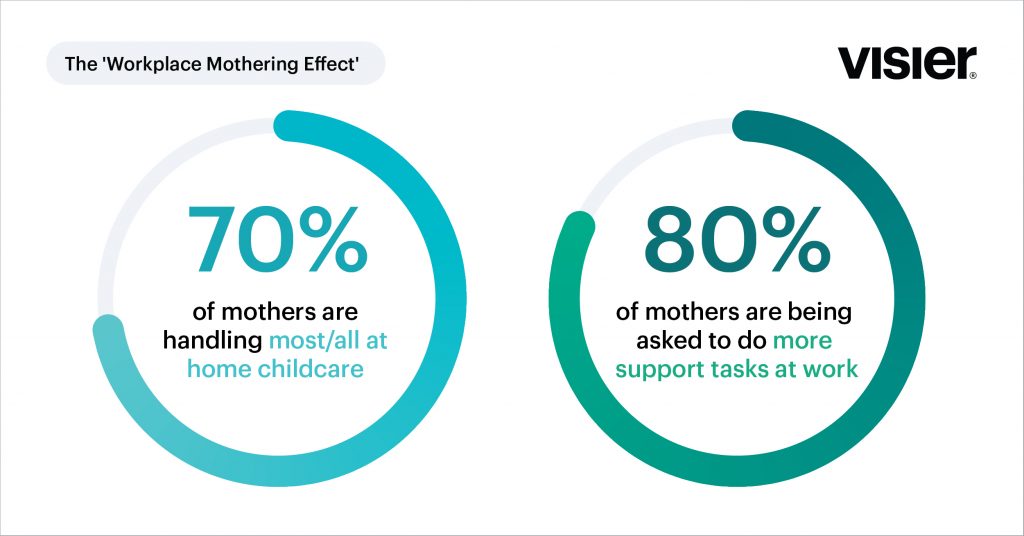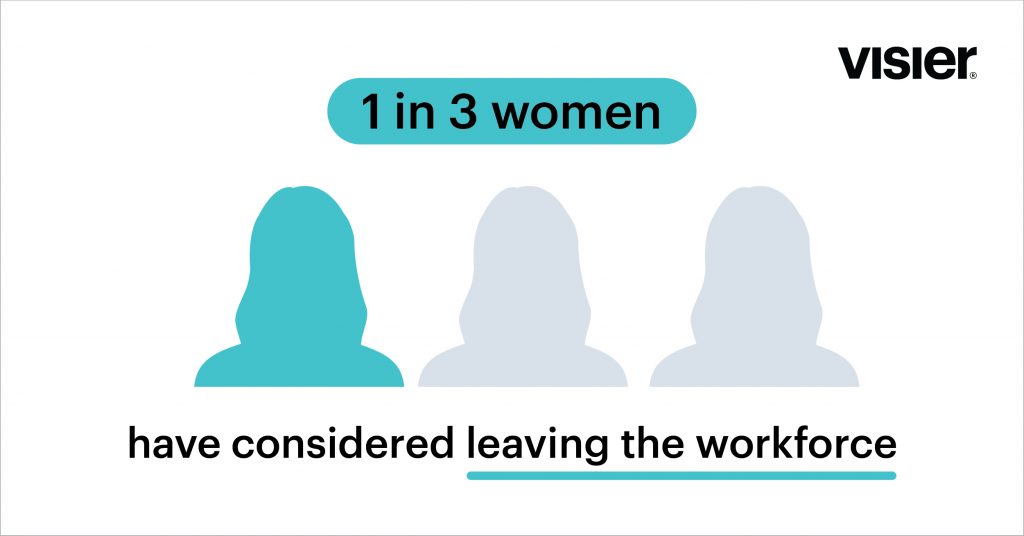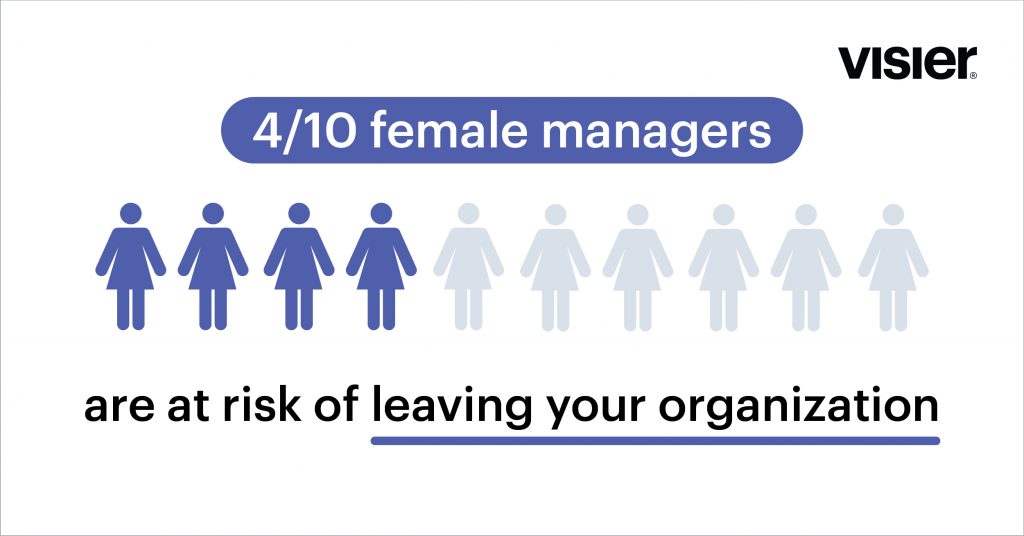Women On the Move? New Survey Uncovers Urgent Need To Empower Female Leaders in Today's Workforce
Empowering female leaders is critical to business success. But many women–burnt out at home and at work–are considering dropping out of the workforce.

Outsmart, the leading people analytics and workforce planning conference, takes place online on May 5-6, 2021. It’s free to register so save your spot today! Improved gender equity and diversity and inclusion are topics you’ll hear at Outsmart so we’re excited to bring you this article. Enjoy!
Improving parity of women in leadership roles helps organizations achieve greater equity, representation, and inclusion—and also better business results. Companies with higher percentages of women in executive positions experience greater profitability, better margins, and higher revenue. Diversity of thought also yields enhanced innovation, mentorship, and collaboration.
Despite these benefits—and the heightened attention on women’s rights and gender equity in recent years—IBM found that women will not achieve leadership equity with men until 2073. Our proprietary research echoes this finding. While women have made gains over the past five years, the Manager Divide still persists: There are far fewer women in management positions than men.
With the rise of remote work, new challenges and opportunities have presented themselves for women in the workplace.
In March 2021, we conducted a study to better understand the Manager Divide and the effect the COVID-19 pandemic has had on women’s career trajectories. We surveyed 1,000 women-identifying employees across job levels and industries in the U.S. Our findings revealed significant opportunities for business and HR leaders to improve female leadership representation and parity, provide better support in the workplace, and prevent the pandemic from erasing gains made thus far.
The pandemic exacerbated female caregiving stereotypes—in the home and at work
Numerous studies over the years have found that women do more of the childcare (or other dependent care) and housework responsibilities than their male partners. Our research was no different: 70% of women indicated imbalanced caregiving responsibilities, while more than one-third said they do 100% of these tasks in their households.

Caregiving breakdown between full-time female workers and their partners:
100/0—I do all of the caregiving: 34%
70/30—I do most of the caregiving: 36%
50/50—We split caregiving equally: 23%
30/70—My partner does most of the caregiving: 3%
0/100—My partner does all of the caregiving: 0%
N/A—I don’t have a partner: 3%
While many women are typically able to offset some of their caregiving duties through school, daycare, and assistance from relatives, this help has been limited over the past year as the pandemic necessitated social distancing. Many working mothers and female caregivers who already felt like they were working a “double shift” (a full workday followed by care work and housework) before the pandemic have found themselves stretched thin juggling around-the-clock childcare, e-learning, or care for another dependent—like an ailing parent—with a full-time workload.
To make matters worse, many women were also asked to take on increased caregiving-type responsibilities in the workplace during the pandemic—what we’re calling the “workplace mothering effect.” Regardless of dependent status, women have long been saddled with stereotypically female or maternal tasks at work.
They are often expected to perform these tasks invisibly, without recognition or additional pay (let alone equal salaries for their core roles). Tasks like remembering coworkers’ birthdays, planning happy hours, cleaning up after meetings, taking notes during meetings, and dispensing career advice often fall on women’s shoulders more than their male counterparts.
Increased responsibilities women took on while working remotely during the pandemic:
Team communication (e.g., company newsletters): 37%
Mentorship of junior employees: 27%
Onboarding of new employees: 22%
Event planning (e.g., virtual happy hours): 22%
Note-taking in meetings: 21%
Leading employee resource, support and/or culture-building groups: 20%
Emotional labor, a concept coined by academic Arlie Hochschild in her 1983 book, “The Managed Heart,” refers to having to “induce or suppress feeling in order to sustain the outward countenance that produces the proper state of mind in others.” Think of a server in a restaurant who has to plaster a smile on her face for customers or laugh off inappropriate comments from her boss.
While men have to perform emotional labor too, we are conditioned to believe women are more empathetic, nurturing, and intuitive than men—and therefore “natural” fits for emotional labor. In an interview with Gemma Hartley, author of “Fed Up: Emotional Labor, Women, and the Way Forward,” Hartley said, “In the workplace, the expectation for women to cushion their responses, manage the emotions of their peers, and make their workplace ‘pleasant’ can hold them back from doing the work that will help them get ahead.”
As the name suggests, emotional labor takes work. But women who choose not to perform it are often labeled as aggressive, cold, or not committed to their organizations.
Keep in mind: Our survey included women without dependents (34%), nearly half of whom reported being asked to increase their workplace care responsibilities, such as event planning and mentorship, during the pandemic. While women with dependents took on these duties at a significantly higher rate, our findings suggest gender bias runs so deep that the “workplace mothering effect” can impact any woman, regardless of dependent status.
Respondents who took on more support tasks at work during the pandemic:
Women with child(ren): 80%
Women with other dependent(s): 84%
Women with child(ren) and other dependent(s): 93%
Women with no dependents: 49%
Cultural assumptions and gender stereotypes result in higher expectations for women to provide care—both in the home in the form of childcare, but also in the workplace in the form of “maternal”-like support for their teams. This imbalance leaves women burnt out and ultimately more likely to exit the workforce.
One in three women are seriously considering dropping out of the workforce entirely
More than one-third (36%) of all women surveyed have considered dropping out of the workforce entirely since March 2020. And nearly half (44%) have considered reducing their work hours and/or responsibilities permanently since the outset of the pandemic. These numbers are even higher for women with child(ren), other dependents, or both: 42% of women in these categories said they’ve considered dropping out of the workforce, and 52% have considered permanently reducing their workloads.

When we asked all respondents what factors would make them consider leaving the workforce, their No. 1 answer choice was if a promotion required a significant amount of more work or hours. This finding suggests the additional support roles women have assumed in the home and/or at work are unsustainable.
Top 5 factors that would make women consider dropping out of the workforce entirely:
A promotion that required a significant amount of more work/hours: 28%
Being passed up or overlooked for a promotion I felt I deserved: 26%
Being called on to care for an adult dependent (e.g., a parent or grandparent) who I don’t care for currently: 23%
A lack of support and/or workplace benefits (e.g., employee resource groups, flexible scheduling, childcare benefits, etc.): 21%
A sexist work culture (e.g., tolerance of sexual harassment, “boys club” attitude, lack of women in leadership, etc.): 18%
Keep in mind: When we honed in on women without dependents, they said the top three factors that would make them consider exiting the workforce were a sexist work culture, being called on to care for an adult dependent, and being passed up for a promotion. Despite differences in dependent status, one thing is clear: Without the parity, support, and recognition they need from their organizations, many women are questioning if their roles are worth it.
U.S. organizations have a lot to make up for in the form of workplace support and benefits
Less than one-third of respondents said their organizations provide paid maternity leave longer than ten weeks (the national average, well below the global average), flexible scheduling for childcare duties, any amount of paid paternity leave, or other forms of workplace support.Types of support respondents’ organizations provide:
Professional development opportunities: 43%
Telecommuting/work-from-home days (pre-pandemic): 34%
Paid maternity leave of longer than ten weeks: 30%
Flexible scheduling for childcare duties: 29%
Paid paternity leave: 28%
Diversity, equity and inclusion strategy and support groups for women: 27%
Childcare flexible spending accounts: 27%
Pay transparency (e.g., publishing salary bands for each position): 23%
Mentorship programs for women: 18%
Employee resource groups for working caregivers: 17%
None of the above: 13%
Do-not-disturb time blocks: 8%
It’s especially concerning that more than one in ten (13%) women said their organizations offered none of the benefits included in our survey. Support comes in many forms. While caring leaders are certainly an important part of the equation, without the critical benefits needed to support women in the workplace, it’s simply not enough.
Additionally, managers are significantly more likely to consider dropping out of the workforce entirely or reducing their workloads permanently. These numbers should sound alarm bells for organizations given the delicate progress made toward elevating women in leadership positions to date. And that’s not to mention the 56% of women overall who said the pandemic set back their career progression.
Women who have considered dropping out of the workforce entirely since March 2020:
Managers: 42%
Non-managers: 20%
Women who have considered reducing their workplace hours and/or responsibilities permanently since March 2020:
Managers: 51%
Non-managers: 25%

Empowering women in leadership
Women may be on the move, but not in the right direction if organizations don’t step up now.
Companies must take steps to elevate and support women in leadership roles now—or the Manager Divide will only widen, and the progress we’ve made over the past few years will be lost. While there’s no “one-size-fits-all” approach to empowering women at work, organizations can lean on data and analytics to identify and measure key drivers of success and growth, as well as areas for improvement. But these tools are only successful with established targets, regular reporting, and ongoing accountability.
Likewise, data and analytics can only get you so far without a culture shift toward a more diverse and inclusive work environment. Business and HR leaders should not only use data to spot trends, but also to speak up, take responsibility, and enact change.
To learn more about using people analytics to improve female leadership representation, read the Visier Insights™ Report: Gender Equity and the Problem of the Manager Divide.



